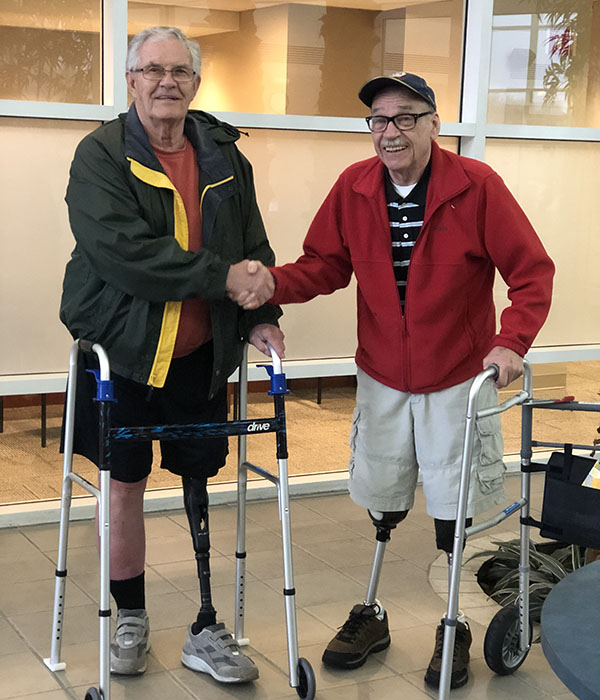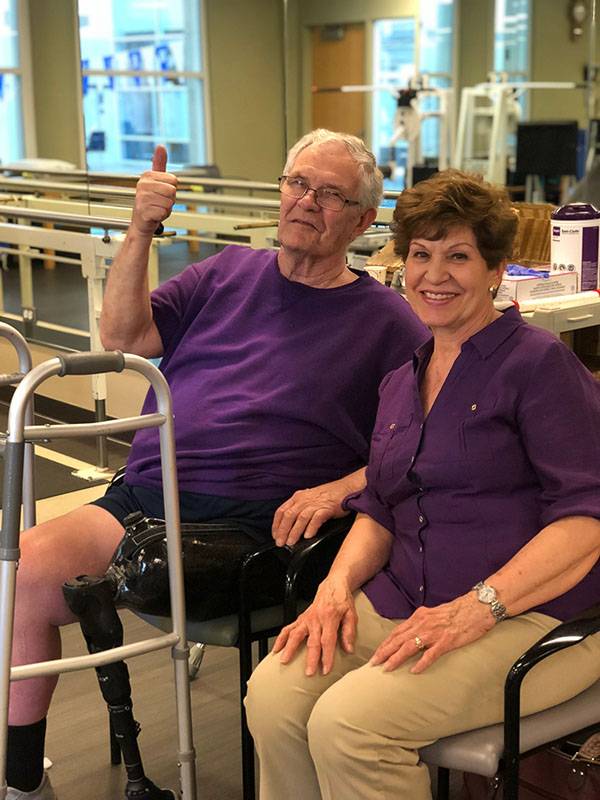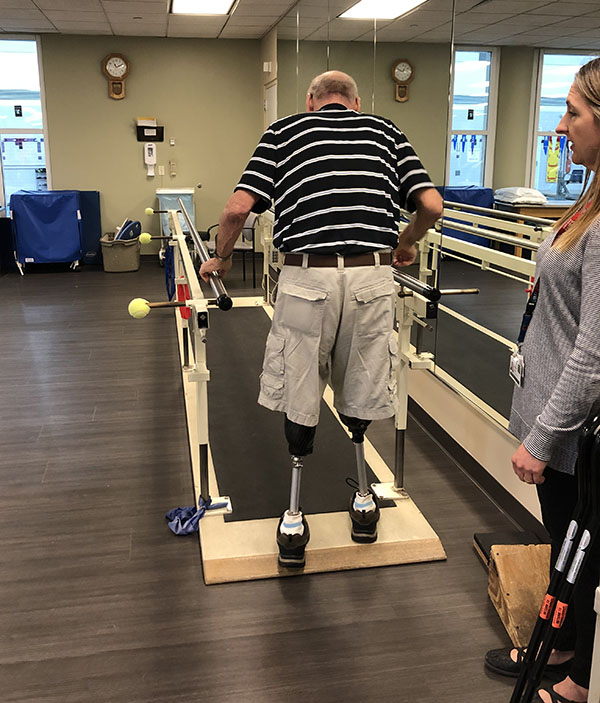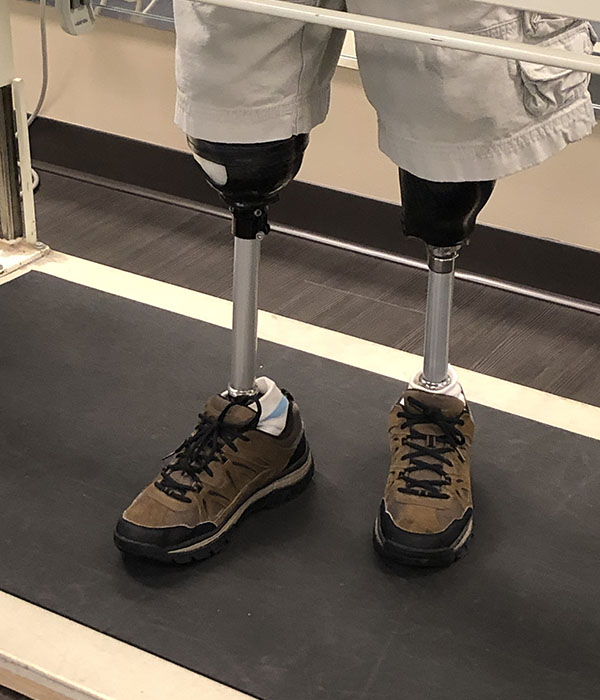Steps toward a new normal
April 24, 2019
Amputees to share stories at inaugural symposium

Physical Therapist Jessica Greve has spent years working with amputees. She and NCH Physical Therapy (PT) Rehab Services Manager Julie Schauble thought it would benefit healthcare providers – not just those at NCH – if the hospital hosted an amputee symposium to share knowledge and enhance care for patients who’ve lost limbs.
“The thought is that with more patients developing diabetes, there are going to be more amputees in the future,” Jessica says. “Most amputees are diabetic, and then there are those who suffer trauma and those who suffer from peripheral vascular disease.”
“Our goal with this and other symposiums is to take a multidisciplinary approach to care,” adds Julie.
When arranging for speakers, Jessica had two patients in mind. They’d both lost legs from peripheral vascular disease due to smoking and said they were eager to share their challenges and what it’s like to take steps – literally – toward a new normal.
Meet Bob

Bob Gurley’s wife Dolores describes him as “hyperactive mentally.” A retired accountant, the 83-year-old Arlington Heights resident smoked for 40 years, not realizing that he was damaging his veins and arteries along the way. Lung cancer? Maybe. Amputation? He never considered it.
“There are 60 known chemical factors in smoke that negatively impact the blood vessels,” says NCH Medical Group Vascular Surgeon John Edwards, M.D., who performed the surgery to remove Bob’s leg. “Smoking, across the board, is the number-one cause of vascular problems and diabetes is the second.”
“He really wishes he could tell everyone that this was from smoking,” says Dolores, while attending PT with Bob.
He lost his left leg after multiple vascular surgeries and also had surgery to save his right leg.
“My goal is to get rid of this walker,” Bob says, as he works on walking with support from parallel bars at the NCH Wellness Center. He asks Jessica, “When are you going to put me in the pool?”
Jessica often has to write new goals for Bob. “He keeps exceeding the ones I set for him,” she says.
Meet Jim

Jim Hudspeth, 70, of Palatine started smoking long before anyone knew its associated health hazards. He was only 10 and living on a farm in central Illinois. He would later develop diabetes. Today, he needs dialysis three times a week to filter his blood. With perseverance and a modified car – he’s now a certified hands-only driver – the double amputee can get to dialysis by himself.
Jim recently returned to PT to meet with Jessica and discuss his new goals: to get rid of his walker and canes. He draws inspiration from a double amputee congressman he saw on the news.
“He walks all over the place, and if he can do that, why can’t I?” Jim says. “I just can’t wait to be able to walk without dragging my walker around.”
Jim says he’s confident that Jessica can help him achieve full mobility.
“She got me to do things I never thought I could do,” Jim says. “I really didn’t know what to expect when I lost my second leg, but I’m having a pretty normal time, considering my situation.”
Though there were several attempts to save Jim’s legs, ultimately his left leg was amputated two years ago and his right one came off in March of 2018. He first noticed something was wrong after NCH Medical Group Podiatric Surgeon Neil Shukla, DPM noticed the nails on his left foot were in poor shape from circulation and referred him to Dr. Edwards.

Both Bob and Jim were diagnosed with chronic atherosclerotic peripheral vascular disease, according to Dr. Edwards. That means the normal delivery of blood through arteries and veins in the legs becomes so restricted that circulation is cut off and the tissue is damaged beyond repair.
“They went through the entire algorithm of limb salvage care and had attempts to do minimally invasive procedures like angioplasty to improve circulation in their legs,” Dr. Edwards says. “Things like this work for a while, but then they fail. Finally they were out of options.”
Bob recalls what that lack of circulation felt like.
“It was spring of 2015 and I recall working in the yard when I could only work for one or two minutes and had to rest for five to 10 minutes because I lost circulation,” Bob says. “Weeks later, I remember getting in the car. My whole foot froze and I could hardly drive back.”
Bob would later learn he had less than 25 percent of blood supplied to his leg. His amputation, which took place in June of 2018, is three inches above his knee. He now wears a prosthetic leg called a “C-leg” which has a computerized knee and a hydraulic ankle that automatically adjusts when it detects elevation.
Bob and Dolores have lived in a tri-level home for 48 years and didn’t wish to move, so they modified it with an office, commode and washing area in the kitchen, a bed in the dining room, and portable steps to get in and out of the house with a walker.
Bob’s able to navigate interior stairs and use the shower with forearm crutches. He can get in and out of the car with a special car cane, a handle support that attaches to the door. “My long-term goal is to be able to walk with forearm crutches,” Bob says.
“His gift is focusing on what he can do, not what he can’t do,” says Jessica. “He doesn’t dwell on the loss.”
If you’re a healthcare provider, you can meet Bob and Jim at the “Amputee Care Across the Continuum” Symposium on Saturday, May 18 from 8 a.m. to 5 p.m. Open to multiple disciplines including physical and occupational therapists, nurses and physicians, it will expand skills and increase confidence for those who work with patients before and after amputation. Future topics are on stroke, chronic pain and concussion management, among others.
Participants receive 8 CEU hours. For more information, visit www.nch.org/symposium.